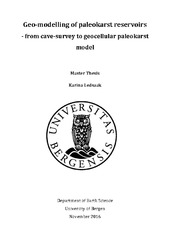Geo-modelling of paleokarst reservoirs - from cave-survey to geocellular paleokarst model
Master thesis
Permanent lenke
https://hdl.handle.net/1956/15419Utgivelsesdato
2016-11-20Metadata
Vis full innførselSamlinger
- Department of Earth Science [1034]
Sammendrag
Hydrocarbon reservoirs exhibiting features inherited from former karst processes acting on the reservoir rocks are relatively common worldwide. However, on the Norwegian continental shelf, paleokarst plays have only recently been identified in the Barents Sea. The substantial resource potential of the new plays is balanced by the known inherent complexity of paleokarst, and highlights the need for improved understanding of these reservoirs. Paleokarst reservoir characteristics are the sum of complex depositional, erosional and diagenetic processes, which tend to produce reservoirs with extreme and highly localized contrasts in permeability. In order to study how different paleokarst reservoirs respond to production and injection it is necessary to employ reservoir models. These models can provide guidelines for production strategies and ensure safe and optimal recovery. As individual paleokarst features are generally below seismic resolution, the obvious way to construct models of likely paleokarst reservoirs is to employ maps of present day karst features as a starting point and forward model their likely collapse, diagenesis and infill. Such models provide analogues for subsurface reservoirs. At present, industrial reservoir modelling software packages do not include dedicated tools or workflows for handling common paleokarst features such as cave networks. For this reason, work- arounds and a lot of out-of-the box" thinking must be applied to create a realistic and natural looking paleokarst reservoir. Some work has previously been done with respect to modelling cave systems in a stochastic manner, but there has been limited work concentrating on deterministically modelling of cave systems based on existing caves. The present thesis is a contribution to this on- going effort. The workflow employs the RMS^TM 2013.1.2 reservoir modelling suite, and is based on a survey of the Setergrotta cave, located in the northern parts of Norway. It allows deterministic incorporation of the original cave geometry into a geo-cellular model. A forward modelling" of the expected collapse and infill was carried out, and the model populated stochastically with likely petrophysical properties. Fracture modelling was performed for the host rock outside the collapsed cave passages and included as part of the petrophysical model. Due to time constraints, only very limited dynamic testing of the final model was carried out. Different upscaled versions of the reservoir model were tested to investigate the effect of upscaling on the fluid flow through the reservoir. Streamline simulations used for this exercise suggests that upscaling up to a certain level does not affect fluid patterns, and that preferential flow along collapsed passages will only occur if there is a strong contrast between permeability of the passages and the surrounding host rock. The streamline simulation results should be subjected to more detailed investigations using more advanced flow simulation tools.
